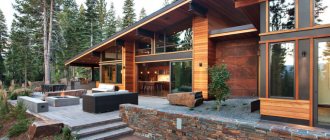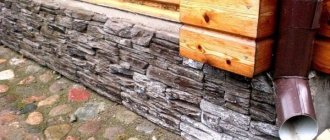The natural beauty of stones has been used in landscape design since ancient times. By arranging the landscape near your home or dacha, you can create original, spectacular compositions. With a competent approach to the selection and installation of boulders and small chips, you can achieve an amazing effect. Here's what a TDA forum user writes:
TDA
Seriously - stones are an excellent material for everything: fences, flower beds, gazebos, houses, paths...
And one cannot but agree with this statement. The range of options for using stones in landscape design is huge. It is important to take into account the general design style of the site and the preferences of the owners in order to achieve a stunning effect. Forum user pavel levchenko writes the following:
pavel levchenko
Friends made a gift - they brought 6 large pink boulder stones to the site with the confidence that I would use them to decorate my virgin landscaping. If anyone has options for using them, please share. Thanks in advance.
We would like to offer several approaches to choosing the design of a personal plot using natural materials.
Where to use the stone?
In the landscape business, there have long been many options for using stone to decorate areas. Almost any modern project cannot do without this kind of decor. So, with the help of stones they design:
- Paths, alleys, entrances to garages or parking spaces;
- Fountains, sides and decorative steps;
- Fences, enclosures, gazebos and arches;
- Slides, waterfalls, “stone streams”;
- Walls of a house, summer kitchen and other buildings;
- Flowerbeds
Of course, nothing limits your imagination here; stones can be used not only for decoration or cladding, but also as an independent element (or even the center) of a composition.
Thus, such projects are usually brought to life by creating a Japanese garden or a Japanese zone on the site, because it is in the culture of this country that raw stone plays a very important role, and for a garden it is simply necessary.
Decorative pebbles for the garden
Pebbles are used for landscaping local and driveway areas, paving paths, and decorating lawns and flower beds.
Laying material in a circle for a decorative area Source skif.websmith.ru
This material looks harmonious with water features: swimming pools, fountains, artificial ponds.
Large boulders of natural shape Source yastroyu.ru
Using pebbles, you can create a platform for an outdoor summer shower.
Stones in a summer shower Source dkds.ru
How to use natural stone in the landscape?
A Japanese garden is a case when you do not need to purchase decorative stone or facing tiles or invite a designer. It will be enough to create a collage yourself (suitable photos of stones in landscape design can be found on the Internet), and then put it into practice.
The more naturalness there is in the selected boulders and pebbles, the more iconic the garden will be. It is especially worth taking a closer look at stones of irregular but streamlined shape: the key to your success is smooth lines and soft transitions, the absence of sharp corners.
Small pebbles should be soft and light; oval, round or bean-shaped: everything in a Japanese garden speaks of softness and tranquility.
Another great solution would be to use natural boulders in any landscape-type landscape design, because the motto here is to imitate nature in all its manifestations. This means you don’t even need to carry boulders from place to place, process them, knocking off sharp corners, clean, split or remove moss and lichen.
All these are traces of natural influence, so for a site drowned in greenery and the shadow of centuries-old trees, a large century-old stone will become an excellent decorative element, visually complementing the composition and as if transporting the viewer somewhere into endless ancient and mysterious forests.
For those who like to put their hand directly into the creation of landscape design, as well as for creative people, there is another way to decorate their site with unique creations of human imagination - painting garden stones.
You can either create complex patterns or simply fill boulders with multi-colored paints, achieving an incredible mixture of shades. Special craftsmen will even be able to create a real masterpiece by depicting a landscape or portrait on the flat side of the stone.
For these purposes, it is better to use acrylic paints or paints in spray cans: they are not washed off with water and wash out more slowly than others.
To give the design a glossy shine and secure the image, you can coat the surface of the stone with a clear varnish, but usually a design with natural wear and slightly faded colors is much more pleasing to the eye than a huge boulder glinting in the sun.
Planting
First, decide what types of plants are suitable for the rock garden. Take your time with landing. To get the desired result, place pots with plants throughout the rockery. Choose the right species that will fit well and will be combined in shape, color, size, texture of leaves and needles, with each other.
Plant alpine plants in spaces between stones for landscaping. Place miniature shrubs among the blocks; be sure to consider how much they will grow in the future.
Fill rocky voids with low-nutrient soil:
- sand,
- Earth,
- fine crushed stone in a ratio of 3:2:1.
Consider what kind of soil different types of plants prefer, acidic, alkaline, neutral. Only then fill the planting areas with suitable soil.
You can easily select the necessary plants for a rock garden and natural landscape stone in garden centers or nurseries. There is no need to rush, first study the characteristics of the species, and only then purchase.
What should be the outcome?
Considering that the plants in the rock garden are small in size, it is necessary to provide an acceptable view from different angles. Hosts and guests should be able to easily admire and appreciate the views. Decorative stones for landscape design, see our photo gallery:
A natural stone
Granite and gneiss. Graceful and aristocratic-conservative, they are used for cladding arbors, arches, fountains and buildings. What is attractive here is the range of eye-pleasing shades, which allows you to choose the ideal color scheme for almost any landscape model.
New Year's crafts from pine cones: decor ideas from pine cones for the New Year- Decorative elements made of stone as an integral part of landscape design
Smartphone case: overview of the main types
Basalt looks interesting in the design of decorative elements of the composition: the range of shades varies from smoky gray to black-green.
Soft rocks: sandstone, slate, limestone, which are most often used to design paths, paths, and lining garages or sheds. Such a stone in decor looks neat and does not catch the eye.
Stones, which are clusters of crystals, give the landscape a special chic. These rocks include marble (easy to process, easy to maintain and allowing you to choose the right color from a huge number of known shades) and porphyry, the color range of which is expressed in various shades of red.
Tuff. It is a porous, lightweight stone, similar to a sponge. It absorbs moisture well and seems to be a clear example of natural erosion - this effect is to the advantage of designers.
Care and maintenance
Natural stone does not require special care. It is enough to remove fallen leaves, remove weeds and clear away dirt. To make maintenance easier, it is important to choose the right type of stone. For example, white marble looks very beautiful in the garden, but quickly loses color and is susceptible to rotting. Whereas a granite boulder is resistant to moss and mold.
Formations on stones can be removed without problems with acid solutions, but not all rocks can withstand their impact. The instructions usually indicate such information.
Phosphorescent stone
The category is completely special. In the light they are no different from other decorative elements and are completely invisible, but at night you will notice a bright glow.
That is why it is worth using it to completely pave paths or simply decorate the border. Also, luminous stones for the garden and landscape are suitable for the sides of pools, ponds and fountains.
Artificial or natural?
Whether to choose artificial or natural material depends on the beliefs and capabilities of the owners of the site. People feel comfortable being surrounded by stones of natural origin. This allows you to find harmony with nature, relax and get rid of stress. Natural boulders in the garden create a unique atmosphere and, as many believe, have a special aura. Their appearance is interesting, rich in a large number of shades, and a unique texture.
The disadvantage of using natural stone is its high cost, heavy weight and difficulty in transportation and installation.
Modern technologies make it possible to create artificial stones that will not look too noticeably different from natural material. They are lightweight, so they are easier to install, especially if you need to do paving. Artificial stones can be hollow; various objects can be hidden in them, for example, pipes or an alarm system.
Paving
Natural stone is used to construct paths and platforms. It can be paving stones, hewn cobblestones, flagstone, crushed stone. Paving is carried out on poured and compacted sand, observing a certain layout. Flagstone can be laid on a concrete base using construction adhesive and jointing. For paving walkways, parking areas, and recreation areas, it is better to choose stones or slabs with a non-slip, but smooth, not too embossed surface.
Limestone (shell rock): studying the advantages
Airy, porous, but quite durable stone interspersed with the remains of biological organisms is suitable for the construction of wall structures of light buildings (gazebos, belvederes, arches, pseudo-antique ruins), and cladding of solid buildings. To increase its service life, it is recommended to treat it with water-repellent compounds.
The color of limestone adds warmth to the atmosphere of country life. Shell rock is used to create garden furniture (benches, deck chairs), and to erect barrier walls separating the garden from the main space. A fence like this looks like a picture from a glossy gardening magazine and has 2 big advantages:
- the area of garden plants warms up better, the walls protect from the effects of winds;
- During natural weathering, the rock enriches the earth with calcium compounds, which are transferred to the “garden dwellers.”
Sandstone - light, beautiful, smooth
Sandstone makes it possible to obtain flat slabs of the required thickness with torn edges; it is widely used to create garden paths, finish the basement of a house, and frame the contours of raised flower beds, creating the desired height.
If the sandstone slabs are not held together with mortar, then the inside of the flowerbed is duplicated with dense geotextiles to prevent the fertile soil from being washed out through the cracks during watering.
When filling the bed of a garden path, geometrically correct sandstone tiles allow you to leave minimal gaps. It is optimal as a material for the construction of retaining walls: a flat surface makes laying easier. Flat faces can be adjusted to each other so well that the “dry masonry” method is sometimes used, excluding binder mixtures. Slabs of reduced thickness are successfully suitable for decorating vertical surfaces and cladding small architectural forms.
Facing
Flagstone and crushed stone can be used as facing material when constructing plinths, columns, retaining walls, parapets, fences and other structures. The cladding is carried out on a solid base using special glue. It is better to plan its “drawing” in advance by arranging the stone elements in the order in which they will be glued to the wall. You can cover any surface, including the bowls of reservoirs and fountains, their outer walls, containers, flowerpots, containers for plants, and stair steps.
Large boulders as an independent decoration
They are laid out on lawns, installed next to ponds, in flower beds, along footpaths. It is better to choose beautiful stones with an unusual texture, with mica inclusions or color transitions. They attract attention and can become the center of a decorative composition if a flower garden is planted around such a boulder. If the area is designed in a landscape style, moss can be grown on the surface of the boulder, and then it will become an independent decorative object.
Large stones are very heavy (can reach several tons). Heavy boulders can sink several centimeters into the ground. If this is undesirable, it is advisable to compact the soil at the installation site and prepare the foundation.











